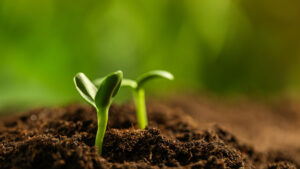When a seed germinates, it has only two days before it has exhausted its reserves to become a seedling capable of photosynthesis. French-speaking researchers unveil the mechanism.
During germination, the embryo must be transformed into a young seedling capable of photosynthesis in less than 48 hours. During this time, it relies solely on his internal reserves, which are quickly consumed. It must therefore create in record time functional chloroplasts, cell organelles that will allow it to produce sugars to ensure its survival. Researchers from the University of Geneva (UNIGE) and the University of Neuchâtel (UniNE) have revealed in the journal Current Biology the key elements that govern the formation of chloroplasts from proplasts, hitherto little studied. Such a mechanism ensures a rapid transition to autonomous growth, as soon as the seed decides to germinate.
The astonishing spread and diversification of flowering plants in the terrestrial environment is mainly due to the appearance of seeds during evolution. The embryo, dormant, is encapsulated and protected in a very resistant structure, which facilitates its dispersion. At this stage, it can not photosynthesize and must consume the nutrient reserves stored in the seed during germination. This process, in turn, induces the transformation of a robust embryo into a fragile young shoot. “This is a critical step in a plant’s life, which is tightly regulated, particularly by gibberellic acid growth hormone (GA). The production of this hormone is suppressed when the external conditions are unfavorable “, explains Luis Lopez-Molina, professor in the Department of Botany and Plant Biology of the Faculty of Sciences of UNIGE.
Import proteins submitted to the cell crusher
The awakening of the embryo causes the differentiation of its proplasts into chloroplasts, real plants capable of producing sugar through photosynthesis. “Thousands of different proteins need to be imported into the developing chloroplasts, and this process can only take place in the presence of a protein called TOC159. If this is lacking, the plant will be free of chloroplasts and will remain albino, “says Felix Kessler, director of the plant physiology laboratory and vice-rector of UniNE.
What is the dialogue that is established at the heart of the seed so that it remains in a protected state or, on the contrary, decides to germinate? “We discovered that, as long as the GA hormone is repressed, a mechanism is set up for the TOC159 proteins to be routed to the cellular road to be degraded,” says Venkatasalam Shanmugabalaji, a researcher in the Neuchâtel group. and first author of the study. In addition, other proteins required for photosynthesis, which TOC159 facilitates import, suffer the same fate.
A high-performance biomechanism
When external conditions become favorable for germination, the concentration of GA hormone increases in the seed. Biologists have shown that it indirectly blocks the degradation of TOC159 proteins. These can be inserted in the membrane of proplasts and allow the importation of cargoes of photosynthetic proteins that escape, too, the cellular road.
The genesis of the first functional chloroplasts, set up in less than 48 hours, ensures a rapid transition from a growth dependent on the reserves of the embryo to an autonomous development. This high-performance mechanism contributes to the survival of the young shoot in an inhospitable environment, in which it will face many challenges.
Source: University of Neuchâtel












